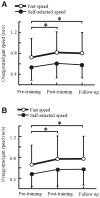Robotic resistance/assistance training improves locomotor function in individuals poststroke: a randomized controlled study
- PMID: 24440365
- PMCID: PMC4076161
- DOI: 10.1016/j.apmr.2013.12.021
Robotic resistance/assistance training improves locomotor function in individuals poststroke: a randomized controlled study
Abstract
Objective: To determine whether providing a controlled resistance versus assistance to the paretic leg at the ankle during treadmill training will improve walking function in individuals poststroke.
Design: Repeated assessment of the same patients with parallel design and randomized controlled study between 2 groups.
Setting: Research units of rehabilitation hospitals.
Participants: Patients (N=30) with chronic stroke.
Intervention: Subjects were stratified based on self-selected walking speed and were randomly assigned to the resistance or assistance training group. For the resistance group, a controlled resistance load was applied to the paretic leg at the ankle to resist leg swing during treadmill walking. For the assistance group, a load that assists swing was applied.
Main outcome measures: Primary outcome measures were walking speed and 6-minute walking distance. Secondary measures included clinical assessments of balance, muscle tone, and quality of life. Outcome measures were evaluated before and after 6 weeks of training and at 8 weeks' follow-up, and compared within group and between the 2 groups.
Results: After 6 weeks of robotic training, walking speed significantly increased for both groups, with no significant differences in walking speed gains observed between the 2 groups. In addition, 6-minute walking distance and balance significantly improved for the assistance group but not for the resistance group.
Conclusions: Applying a controlled resistance or an assistance load to the paretic leg during treadmill training may induce improvements in walking speed in individuals poststroke. Resistance training was not superior to assistance training in improving locomotor function in individuals poststroke.
Keywords: Gait; Hemiplegia; Recovery of function; Rehabilitation; Robotics; Walking.
Copyright © 2014 American Congress of Rehabilitation Medicine. Published by Elsevier Inc. All rights reserved.
Conflict of interest statement
Statement of Interest
Competing financial interests. Johnson and Johnson, Lundbeck, Pfizer, GSK, Puretech Ventures, Merck, Takeda, Dainippon Sumitomo, Otsuka, Lilly, Roche, Asubio (A.A.G.). All other authors have no biomedical financial interests or potential conflicts of interest to report.
Figures




References
-
- Perry J, Garrett M, Gronley JK, Mulroy SJ. Classification of walking handicap in the stroke population. Stroke. 1995;26:982–9. - PubMed
-
- von Schroeder HP, Coutts RD, Lyden PD, Billings E, Jr, Nickel VL. Gait parameters following stroke: a practical assessment. J Rehabil Res Dev. 1995;32:25–31. - PubMed
-
- Dean CM, Richards CL, Malouin F. Walking speed over 10 metres overestimates locomotor capacity after stroke. Clin Rehabil. 2001;15:415–21. - PubMed
-
- Hsu AL, Tang PF, Jan MH. Analysis of impairments influencing gait velocity and asymmetry of hemiplegic patients after mild to moderate stroke. Arch Phys Med Rehabil. 2003;84:1185–93. - PubMed
-
- Treger I, Shames J, Giaquinto S, Ring H. Return to work in stroke patients. Disabil Rehabil. 2007;29:1397–403. - PubMed
Publication types
MeSH terms
Grants and funding
LinkOut - more resources
Full Text Sources
Other Literature Sources
Medical

